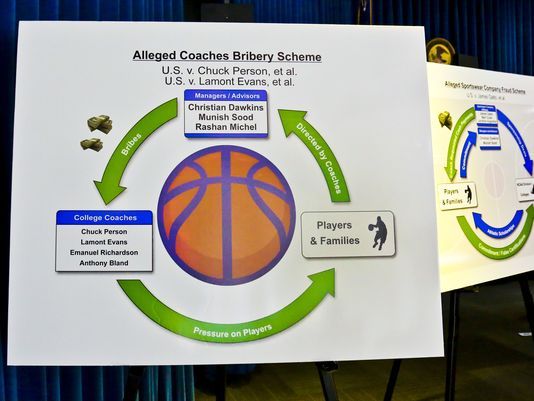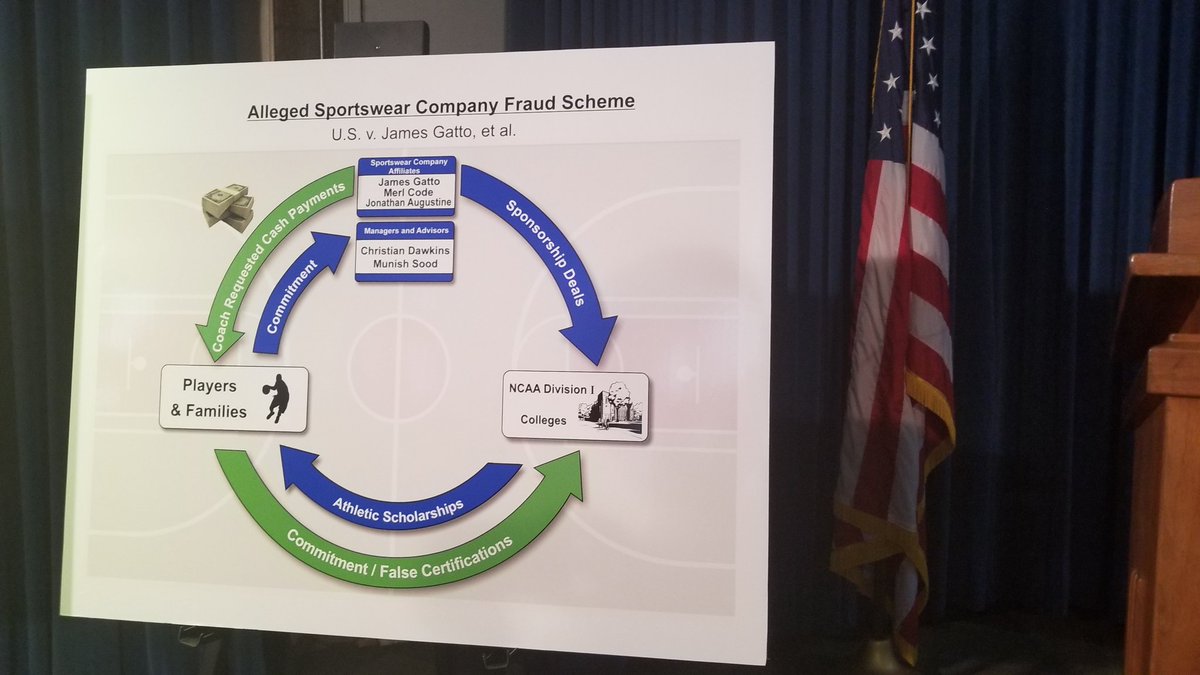We were watching Joon H. Kim, U.S. Attorney for the Southern District of New York, deliver the news about the NCAA basketball bribery and sportswear (read Adidas, and coming soon to a theater near you, Nike and Under Armour) charges. However, as we watched, we couldn’t help but sense a familiar feeling, like we had seen this all unfold before.
Yes, this felt like that scene in The Wire [1] where the mayor called for increased support to help the victimized homeless. [2] Nobody cares about the homeless. They have no political lobby, so the mayor wanted to stand up for them. The mayor seemed genuine too. Of course if you watch the clip, you’ll see that it was all for show in the eyes of anyone who had seen politicians make promises before.
That’s when it hit us. The “dark underbelly of college basketball” is exactly like the illicit drug trade in The Wire. Of course we don’t mean to suggest that the shady side of NCAA athletics destroys nearly as many lives as cocaine, meth, or heroin (Penn State, Baylor, and the like notwithstanding). But it’s hard not to draw parallels in the way society treats both the “dark underbelly of college basketball” and the drug game. We can tell that you’re probably lost, so let us help you using, again, The Wire. After you read this, you’ll have a better understanding of how that dark belly operated. And in the process, you will begin to see the similarities between U.S. drug enforcement and the black market in college basketball. We’re even breaking out the U.S. Attorney’s charts for you!
Here’s Chart One:

And Chart Two:

So we have five groups of people/entities: 1) The Basketball Players [3]; 2) NCAA Coaches; 3) Managers/Agents/Advisors; 4) The Shoe Companies; and 5) The NCAA. The charts above say “NCAA Colleges” but that’s because the U.S. Attorney is painting them as victims. The schools may not have known about the actions of their individual coaches, but make no mistake, they’re not victims in the game (The NCAA just extended its TV deal for another 8 years to the tune of $8.8 billion for March Madness alone).
1. THE BASKETBALL PLAYERS
D’Angelo had it right. The soldiers in the drug crews, the petty dealers, are the pawns. They take the most risk and hold the least value in the game. If a pawn falls, there’s another one right next to it. The petty dealers are the ones who get killed, beat up by the cops, and thrown in jail. Every now and again there’s one that is able to climb his way to the other side, but it’s rare.
In the game of college basketball, there are plenty of players who have been sold the NBA dream. But how many have been used and then kicked to the curb? Players get injured, don’t make it, flame out. Even some of the ones that make it get used by the people who are supposed to be looking out for them. Everybody’s got a hand in their pockets. Some of the players make it. But just remember that for every LeBron James, there are a whole lot more Schea Cottons. If your response to that sentence is, “who’s Schea Cotton?” then our response to you is, “exactly.”
2. THE NCAA COACHES
These are the well-paid guys who make it to the top of the local drug game but never escape that world. Your Stringer Bells, Avon Barksdales, Prop Joes, and Marlo Stanfields. They usually end up in jail at some point. Some get killed. But while they’re on top, they are swimming in some serious money. And if they’re smart, they can set themselves up for life with the money they make while they rule their street corners.
NCAA coaches like Rick Pitino make great money, millions of dollars. But they don’t make Fortune 500 money. Additionally, the odds of a coach having a Mike Krzyzewski at Duke-like tenure are next to none. Most get fired, either for a bad season, bad recruiting runs, or for getting caught in hooker and bribery scandals like Pitino. Some coaches then get hired by other schools or go into TV, but there are plenty who are never heard from again. As for the relationships between the coaches and the players, sure, the coaches care about their players. They want their players to succeed. In many ways, they’re in the game together and fighting the same battles. However, when push comes to shove, most coaches have no problem abandoning their players. Just look at how many coaches take new jobs at different schools just after recruiting a bunch of kids and selling them on the school they’re planning to leave. There isn’t a lot of loyalty in the game. [4]
3. MANAGERS/AGENTS/ADVISORS
Here’s where we start to get into the murkier ground in terms of the “underbelly.” These are the criminal defense lawyers and businessmen. The businessmen convince the local drug kingpins that they need advice in handling their money. The lawyer, Maury Levy in The Wire, sometimes refers his clients to “the right people.” The businessmen tell the drug dealers that they can make legitimate money for the dealers and increase their earnings while at the same time washing their illegal drug profits. When the dealers inevitably catch cases, the criminal defense lawyer is there to cash in again by representing the dealers in the criminal cases.
In the sports world, of course there are agents, managers, and advisors who do right by their clients just as there are plenty of coaches who do right by their players. Nothing is better for a player than having people around him who have his best interests at heart. However, the dirty ones? There’s nothing worse. They prey on the players from the time that they’re kids and line their pockets off of the kids’ work. And if that wasn’t enough, some double dip and run Ponzi schemes, taking a player’ s money for themselves then replenishing that sum with another player’s money until the pyramid collapses. And it always does.
4. THE SHOE COMPANIES
Now we’re getting to the real heavy hitters. These are the greasers, the ones who make the big money. They are heavily connected and run distribution networks. They keep their noses out of trouble and deal in large quantities only. We’re talking about “the Greeks.” They bring the drugs in and sell them to local crews for much more than it cost them. One thing you’ll notice in The Wire: the crews running the streets changed, but the Greeks kept making their money, even when trouble came around. They’re connected to the right people, which ensures their money and survival.
The shoe companies are not much different. As we’re seeing this matter play out, some high level guys are being indicted, but it’s not like you’re going to see Phil Knight (head of Nike) or Kasper Rørsted (CEO of Adidas-Group) take a fall any time soon. Their underlings bribe coaches and handlers. Their underlings provide the bribe money for the players. And their underlings will be the ones taking the fall.
To the shoe companies, these federal charges are a problem, but they are just a cost of doing business at this point. The companies will change how the bribery happens, but it’s not going to stop. Just as with the drug game, there is too much money to be made. LeBron James signed a lifetime contract with Nike in 2015 that may be worth $1 billion according to Maverick Carter, LeBron’s business manager. If LeBron is going to earn $1 billion or anything close to it, how much do you think Nike plans to make off of that deal? That’s why these shoe companies will not stop trying to get these kids early. A few hundred thousand here and there is nothing when the right player can be worth billions in revenue. Underlings can be replaced. The game will stay the same.
5. THE NCAA
These are the guys that seem clean but have their hands in plenty that the public doesn’t care to realize. The politicians, represented best in The Wire by State Senator Clay Davis, do it best. Senator Davis stays above the fray. He takes “political donations” from lobbyists and all kinds of bribes from everybody else. His PR is so impeccable that even when he gets charged for his crimes, the jury sets him free. No government official big enough to make a difference in the drug game ever goes down. The politicians scapegoat a few police officers and then it’s back to business. Even if a politician does go down, another one is there to take his place. The system goes on.
The charges in the NCAA bribery case don’t surprise anyone. We’ve always known about the “underbelly” just as we know about the drug game. We know that the only way to fix the problem is to legalize the game and regulate it. Let the players get paid and market themselves while employing people to represent them. You do that and most of the underbelly goes away. But there are too many people making too much money for that to happen. Why do you think the NCAA penalties haven’t resulted in changes when it comes to recruiting. The NCAA doesn’t really want to police its member universities. Where’s the incentive in doing that?
Nothing is going to change with regard to the NCAA without a sustained public outcry for that change. Hamsterdam worked in The Wire but once the powers that be caught wind that a police unit was regulating the sale of drugs, bye bye Hamsterdam. It didn’t matter that Hamsterdam reduced violence and made the community safer. For that reason Hamsterdam was actually the biggest fiction in The Wire. No way is anyone going to risk his neck and legalize the game in real life.
Rest assured that the dust will settle after the U.S. Attorneys’ college basketball case comes to a close. After that, college basketball will go back to business as usual. The shoe companies as well as the managers/agents/advisors will become more sophisticated in their schemes just as Marlo did with the cell phone messages. Then, inevitably, someone will get caught up in another scandal. But we’ll all know better. After all, whether we’re talking about the NCAA or the drug game, Omar said it best. It’s “all in the game.”
[1] Spoiler alert for this entire column. If you haven’t seen The Wire and are planning on it, stop reading and go binge watch the series immediately. Then read this column.
[2] Not important to this column but important to The Wire is that McNulty made up the killer by staging crime scenes with already dead people. He made it seem like a serial killer was running around biting then killing the homeless in order to get more officers that he could use for a case that he was working on.
[3] The charts include the players’ families but we place some blame on the parents who were involved, not nearly as much as on the rest of the bad actors, but definitely some. Think Namond’s mother trying to groom him as a dealer to follow in his father, Wee-Bey’s footsteps.
[4] If you’re looking for a The Wire corollary, just remember, “where’s Wallace?” and Stringer walking away.




















Pingback: Week 8 NCAA Football Picks From Yahoo's 2016 College Pick'Em Champion - Rudin Writes
Pingback: A 2018 Sports and Politics Preview - 365 Questions and Answers - Rudin Writes
Pingback: Sports and Politics Preview - The Top 100 Questions and Answers For 2018 - Rudin Writes
Pingback: UCLA Win Over USC - An Exciting But Uninspiring Win - Rudin Writes
Pingback: It's Madness - 2018 - Rudin Writes
Pingback: It's Madness - 2019 - Rudin Writes